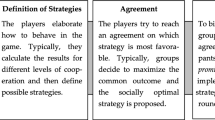Abstract
This paper describes and analyzes the central role of human–human communication in a dynamic, high-risk environment. The empirical example is a UN peace-enforcing and peace-keeping operation where uncertainty about the situation in the environment and about the own organization’s capability was intertwined, requiring extensive control activities and, hence, special attention to communication between humans. Theoretically, focus lays on what efficient communication means, how to understand and use social relations, and use technology when making socio-technical systems also cooperative systems. We conclude that “control” largely is based on the ability to communicate and that efficient human–human communication is grounded in relations between individuals, which preferably should be based on physical meetings. Uncertainty, and how humans cope with it through interpersonal communication, is exemplified and discussed. In theoretical terms, relating the study to systems science and its application in organizational life and cognitive engineering, the case illustrates that an organization is not only an economy but also an adaptive social structure. But neither cognition nor control is an end state. The organization’s raison d’être in this kind of operation is cooperation rather than confrontation. Its use of force is strictly regulated by Rules of Engagement (ROE). In the organization, strong emotions may govern, interpersonal trust can be established and rule-sets for further cooperation established. Without considering the power of such aspects, economical rationality and detached cognitive thinking may end up in perfect, but less relevant, support technologies where people act in roles rather than as wholes.
Similar content being viewed by others
Notes
“Private Petterson” is probably a metaphor for any soldier. Petterson is a very common last name in Sweden.
References
Ackoff RL (1975) Towards a system of system concepts. General systems, cybernetics and informatics. Samuelson K (ed) Society for General Systems Research: general systems, cybernetics and informatics. Background papers to conference Cybernetics, Systems and Informatics, 12 November 1975, pp 55–62
Clark HH (1996) Using language. Cambridge University Press, Cambridge
Hartley P (1993) Interpersonal communication. Routledge, London
Jackson MC (1991) Systems methodology for management sciences. Plenum Publishing Corporation, New York
Lave J, Wenger E (1991) Situated learning—legitimate peripheral participation. Cambridge University Press, Cambridge
McCann C, Pigeau R (2000) The human in command. In: McCann C, Pigeau R (eds) The human in command: exploring the modern military experience. Kluwer Academic/Plenum Publishers, New York
Persson P-A (1995) Support for command and control in multinational and multicultural environments. The first international symposium on command and control research and technology. National Defence University, Washington DC
Persson P-A (1996) From theoretical pragmatism to pragmatic theory: a qualitative analysis of coalition command and control. The Swedish War College, Department of Military Technology, Stockholm
Persson P-A (1997) Toward a grounded theory for support of command and control in military coalitions. Department of Computer and Information Science, Linköpings universitet, thesis No 150, Linköping
Richardson GP (1991) Feedback thought in social science and systems theory. University of Pennsylvania Press, Philadelphia
Selznick P (1969) Foundations of the theory of organizations. Systems thinking, vol 1, Emery FE (ed). Penguin, Harmondsworth, pp 261–280
Shannon CE, Weaver W (1949) The mathematical theory of communication. University of Illinois, Urbana
Strauss A, Corbin J (1990) Basics of qualitative research. SAGE Publications, London
Weick KE (1993) The collapse of sensemaking in organizations: the Mann Gulch disaster. Adm Sci Quart 38:628–652
Watts BD (2004) Clausewitzian friction and future war. Institute for National Strategic Studies, NDU, Washington DC
Wiener N (1948) Cybernetics or control and communication in the animal and the machine. MIT Press, Cambridge
Author information
Authors and Affiliations
Corresponding author
Rights and permissions
About this article
Cite this article
Johansson, B.J.E., Persson, PA. Reduced uncertainty through human communication in complex environments. Cogn Tech Work 11, 205–214 (2009). https://doi.org/10.1007/s10111-007-0108-6
Received:
Accepted:
Published:
Issue Date:
DOI: https://doi.org/10.1007/s10111-007-0108-6




